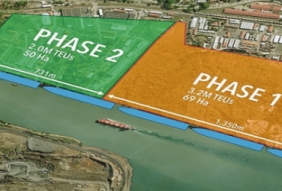
Posted on May 10, 2016
By Greg Miller, Fairplay
APM Terminals, Terminal Link, Terminal Investments Ltd (TIL), and PSA International have pre-qualified for bidding on Panama’s proposed Corozal container terminal, according to the Panama Canal Authority (ACP). Three other interested parties – Mitsui OSK Lines, Manzanillo International Terminal (MIT), and Ports America – failed to make the cut.
Which company ultimately wins the concession could affect future routing for east-west container services via the expanded Panama Canal, given the liner ties of three of the potential bidders: APM is part of the Maersk group, Terminal Link is majority-owned by CMA CGM, and TIL serves MSC.
The Corozal terminal is planned for ACP land on the east bank of the expanded Panama Canal, near the Pacific entrance. As with the Hutchison-operated Balboa terminal on the Pacific side’s east bank, the new Corozal terminal would have access to the Panama Canal Railway, which currently transports containers between Balboa and three Atlantic coast terminals: SSA-operated MIT, Hutchison-run Cristobal, and Evergreen-run Colon Container Terminal. Also located near the canal’s Pacific entrance – but on the western bank of the canal and without rail access – is the PSA-Panama terminal, which is now in the process of expanding.
The canal and the multiple terminals at either entrance, together with the railway running adjacent to the waterway, comprise a broader transhipment network that allows container lines to drop off boxes at either canal entrance, with the railway providing the flexibility to unload boxes on the Pacific side that are bound for Atlantic Basin destinations, and vice versa.
The ACP contends that terminals on the Pacific side have been operating “at very close to capacity”, and “if we do not increase port capacity in the Pacific, the additional transhipment volume that would arise from the canal expansion would have to be handled in other regional hubs” in Colombia, Mexico, and Peru on the Pacific side, and in Colombia and the Caribbean islands on the Atlantic side.
When announcing the final four pre-qualified parties on 3 May, ACP administrator Jorge Quijano said that bidding interest demonstrated “the potential of the Corozal port and the confidence of the leading port operators in the world”. He also emphasised that Corozal “is certain to enhance the canal’s offering and revenue base”.
If the Corozal project moves forward, the terminal would have total capacity of 5.3 million teu per year, and would be built in two phases. Phase one would comprise 1,350 m of quay and 66 ha of yard space, with a capacity of 3.2 million teu per year. Phase two would be comprised of an additional 731 m of quay and 56 ha of yard space, with incremental capacity of 2.1 million teu per year. The winning bidder would have a 20-year concession, renewable for an additional 20 years.
The Corozal plan continues to face opposition in Panama, and its development is not assured. Since 2015, passage has been sought for legislation that would provide Corozal with the same tax incentives as the country’s other private terminals, but as of 4 May, the legislation has not yet been approved by the National Assembly. Quijano told IHS Fairplay in 2015 that if incentives are not secured for Corozal, that facility would be at a competitive disadvantage to other terminals in Panama, lowering the value of the concession.
Opponents of the Corozal plan have noted that terminal throughput on the Pacific side of the canal has actually fallen, raising the question of whether a major new competitor is needed.
According to the latest statistics from the Panama Maritime Authority, throughput at Balboa in January–February 2016 fell 12.7% year on year (y/y), and dropped 4.9% y/y in full-year 2015.
The pro-Corozal argument was outlined to IHS Fairplay last year by a port executive who declined to be identified. “The port operators in Panama have to be ready for surges in transhipment cargo after carriers implement complete network re-configurations [following canal expansion],” he explained. “If you have terminal operators interested in investing in a facility like Corozal and there’s little space to grow [at other sites] on the Pacific side, it’s difficult to see a logical reason to oppose such a project. We can’t draw a national port strategy based on a few years of underperformance.”
Source: Fairplay





